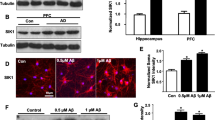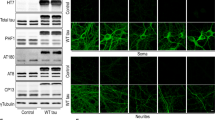Abstract
A presenilin 2 mutation is believed to be involved in the development of Alzheimer's disease. In addition, transgenic mice with a presenilin 2 mutation have been reported to have learning and memory impairments. In this study, exposing PC12 cells expressing mutant presenilin 2 to 50 μM Aß25–35, 30 mMl-glutamate and 50 μM H2O2 caused a significant increase in acetylcholine esterase activity. Anin vivo study revealed high levels of this enzyme activity in the mutant presenilin 2 transgenic brains compared with the wild type presenilin 2 transgenic and non-transgenic samples. These results suggest that a mutant presenilin 2-induced neurodegeneration in Alzheimer's disease might be involved in the increase in acetylcholinesterase activity. These findings might help in the development of an appropriate therapeutic intervention targeting mutant presenilin 2-induced Alzheimer's disease.
Similar content being viewed by others
References
Alvarez, A., Alarcon, R., Opazo, C., Campos, E. O., Munoz, F. J., Calderon, F. H., Dajas, F., Gentry, M. K., Doctor, B. P., De Mello, F. G., and Inestrosa, N. C. Stable complexes involving acetylcholinesterase and amyloid beta peptide change the biochemical properties of the enzyme and increase the neurotoxicity of Alzheimer's fibrils.J. Neurosci., 18, 3213–3223 (1999).
Alves da Costa, C., Paitel, E., Mattson, M. P., Amson, R., Telerman, A., Ancolio, K., and Checler, F. Wild-type and mutated presenilins 2 trigger p53-dependent apoptosis and down-regulate presenilin 1 expression in HEK293 human cells and in murine neurons.Proc. Natl. Acad. Sci. U.S.A., 99, 4043–4048 (2002).
Araki, W., Yuasa, K., Takeda, S., Takeda, K., Shirotani, K., Takahashi, K., and Tabira, T. Pro apoptotic effect of presenilin 2 (PS2) overexpression is associated with down regulation of Bcl2 in cultured neurons.J. Neurochem., 79, 1161–1168 (2001).
Deng, G., Pike, C. J., and Cotman, C. W. Alzheimer's associated presenilin2 confers increased sensitivity to apoptosis in PC12 cells.FEBS Lett., 397, 50–54 (1996).
Ellman, G. L., Courtney, K. D., Andres, V. Jr., and Featherstone, R. M., A new and rapid colorimetric determination of acetylcholinesterase activity.Biochem. Pharmacol., 7, 88–95 (1961).
Fodero, L. R., Mok, S. S., Losic, D., Martin, L. L., Aguilar, M. I., Barrow, C. J., Livett, B. G., and Small, D. H. Alpha7-nicotinic acetylcholine receptors mediate an Abeta (1–42)-induced increase in the level of acetylcholinesterase in primary cortical neurones.J. Neurochem., 88, 1186–1193 (2004).
Hu, W., Gray, N. W., and Brimijoin, S. Amyloid-beta increases acetylcholinesterase expression in neuroblastoma cells by reducing enzyme degradation.J. Neurochem., 86, 470–478 (2003).
Hwang, D. Y., Chae, K. R., Kang, T. S., Hwang, J. H., Lim, C. H., Kang, H. K., Goo, J. S., Lee, M. R., Lim, H. J., Min, S. H., Cho, J. Y., Hong, J. T., Song, C. W., Paik, S. G., Cho, J. S., and Kim, Y. K. Alterations in behavior, amyloid beta-42, caspase-3, and Cox-2 in mutant PS2 transgenic mouse model of Alzheimer's disease.FASEB J., 16, 805–813 (2002).
Inestrosa, N. C., Alvarez, A., Perez, C. A., Moreno, R. D., Vicente, M., Linker, C., Casaneuva, O. I., Soto, C., and Garrido, J. Acetylcholinesterase accelerates assembly of amyloid beta peptides into Alzheimer's fibrils: Possible role of the periferal site of the enzyme.Neuron, 16, 881–891 (1996).
Janicki, S. M. and Monterio, M. J., Presenilin overexpression arrests cells in the G1 phase of cell cycle. Arrest potentiated by the Alzheimer's disease PS2 (N141l) mutant.Am. J. Pathol., 155, 135–144 (1999).
Janicki, S. and Montaeiro, M. J., Increase apoptosis arising from increased expression of the Alzheimer's disease-associated presenilin 2 mutation (N141l).J. Cell Biol., 139, 485–495 (1997).
Kuhl, D. E., Koeppe, R. A., Minoshima, S., Snyder, S. E., Ficaro, E. P., Foster, N. L., Frey, K. A. and Kilbourn, M. R.,In vivo mapping of cerebral acetylcholinesterase activity in aging and Alzheimer's disease.Neurology, 52, 691–699 (1999).
Lee, S.Y., Hwang D. Y., Kim, Y. K., Lee, J. W., Shin, I. C., Oh, K. W., Lee, M. K. Lim, J. S., Yoon, D. Y., Hwang, S. J., and Hong, J. T., PS2 mutation increases neuronal cell vulnerability to neurotoxicants through activation of caspase-3 by enhancing of ryanodine receptor-mediated calcium release.FASEB J., in press (2005).
Lei, Y., Heng, Y. H., and Xue, J. Z. Increase expression of intranuclear AChE involved in apoptosis of SK-N-SH cells.Neurosci. Res., 42, 261–268 (2002).
Li, Y., Liu, L., Kang, J., Sheng J. G., Barger, S. W., Mrak, R. E., and Griffin, W. S. Neuronal-glial interactions mediated by interleukin-1 enhance neuronal acetylcholinesterase activity and mRNA expression.J. Neurosci., 20, 149–155, (2000).
Melo, J. B., Agostinho, P., and Oliveira, C. R. Involvement of oxidative stress in the enhancement of acetylcholinesterase activity induced by amyloid beta-peptide.Neurosci. Res., 45, 117–127 (2003).
Mori, M., Nakagami, H., Morishita, R., Mitsuda, N., Yamamoto, K., Yoshimura, S., Ohkubo, N., Sato, N., Ogihara, T., and Kaneda, Y. N141l mutant presenilin 2 gene enhances neuronal cell death and decrease bcl2 expression.Life Sci., 70, 2567–2580 (2002).
Nguyen, H. N., Lee, S. Y., Hwang, D. Y., Kim, Y. K., Yuk, D. Y., Lee, J. S., and Hong, J. T. Decrease in NF-kappaB, AP-1 and SP-1 activities in neuronal cells expressing presenilin 2.Neuroreport, 16, 731–735 (2005).
Rees, T., Hammond, P. I., Soreq, H., Younkin, S., and Brimijoin, S., Acetylcholinesterase promotes beta-amyloid plaques in cerebral cortex.Neurobiol. Aging, 24, 777–787 (2003).
Rocchi, A., Pellegrini, S., Siciliano, G., and Murri, L. Causative and susceptibility genes for Alzheimer's disease: A review.Brain Res. Bull., 61, 1–24 (2003).
Saez-Valero, J., Fodero, L. R., White, A. R., Barrow, C. J., Small, D. H. Acetylcholinesterase is increased in mouse neuronal and astrocyte cultures after treatment with beta-amyloid peptides.Brain Res., 965, 283–286 (2003).
Sbema, G., Saez-Valero, J., Beyreuther, K., Masters, C. L., and Small, D. H. The amyloid beta-protein of Alzheimer's disease increases acetylcholinesterase expression by increasing intracellular calcium in embryonal carcinoma P19 cells.J. Neurochem., 69, 1177–1184 (1997).
Shen, Z. X. Brain cholinesterase: The molecular and cellular basis of Alzheimer's disease.Med. Hypotheses, 63, 308–321 (2004).
Song, Y. S., Park, H. J., Kim, S. Y., Lee, S. H., Yoo, H. S., Lee, H. S., Lee, M. K., Oh, K. W., Kang, S. K., Lee, S. E., and Hong, J. T. Protective role of Bcl-2 on beta-amyloid-induced cell death of differentiated PC12 cells: Reduction of NF-kappaB and p38 MAP kinase activation.Neurosci. Res., 49, 69–80 (2004).
Tamotsu, H. G., Atsushi, T., Yoshihisa, W., Naoyuki, I., Takashi, M., and Takeshi, T. A unifying model for functional difference and redundancy of presenilin-1 and-2 in cell apoptosis and differentiation.Gene, 34257, 1–9 (2003).
Vito, P., Lacana, E., and D'Adamio, L. Interfering with apoptosis: Ca-binding protein ALG-2 and Alzheimer's disease gene ALG-3.Science, 271, 521–525 (1996).
Vito, P., Wolozin, B., Ganjei, J. K., Iwasaki, K., Lacana, E., and D'Adamio, L. Requirement of the familial Alzheimer's disease gene PS2 for apoptosis. Opposing effect of ALG-3.J. Biol. Chem., 271, 31025–31028 (1996).
Yang, L., He, H. Y., Zhang, X. J. Increased expression of intranuclear AChE involved in apoptosis of SK-N-SH cells.Neurosci. Res., 42, 261–268 (2002).
Zhang, H. Y., Brimijoin, S., and Tang, X. C. Apoptosis induced by beta-amyloid 25–35 in acetylcholinesterase-overexpressing neuroblastoma cells.Acta Pharmacol. Sin., 24, 853–858, (2003).
Author information
Authors and Affiliations
Corresponding author
Rights and permissions
About this article
Cite this article
Nguyen, H.N., Hwang, D.Y., Kim, Y.K. et al. Mutant presenilin 2 increases acetylcholinesterase activity in neuronal cells. Arch Pharm Res 28, 1073–1078 (2005). https://doi.org/10.1007/BF02977404
Received:
Issue Date:
DOI: https://doi.org/10.1007/BF02977404




